Sport Pilot Allows ANN Staffer To Take To Skies Again
by ANN Managing Editor Rob Finfrock
The morning of January 24, 2007 was a cloudy and
cold one in the Dallas/Fort Worth metroplex... and I was concerned
with just how low those clouds were. Fortunately, despite some
ominous-looking wisps over my apartment in Addison, a call to the
field AWOS told me the ceiling was considerably higher over Grand
Prairie Municipal, 30 miles southwest... and that's all that
mattered.
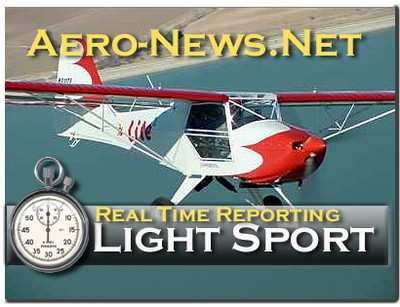
This was gonna happen. After 17 months stuck on the ground,
except for several airline flights and a few demo rides, I was
going to fly again.
Next up was a stop at Starbucks -- a preflight ritual of mine,
dating back several years -- before I drove through rush hour to
GPM, just south of DFW International. My heart was going a
mile-a-minute... much faster than traffic was slogging along
the Bush Turnpike.
Even with the traffic, I arrived at GPM a full 30 minutes before
my lesson was scheduled to begin. When I walked into the
office of Aviator Air, my instructor, Jay Hencken (below), was
waiting for me.
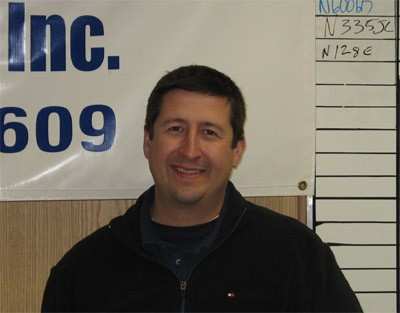
"Ready to go?"
"Absolutely," I said, trying to temper my giddy enthusiasm and
focus on the task at hand.
My chariot back into the skies is the Evektor SportStar SE, the
first aircraft to be certified under the FAA's light-sport aircraft
rules. The low-wing LSA follows the light sport guidelines to the
letter: two-seats, gross weight less than 1,320 lbs, Rotax 100-hp
engine.
From the beginning of my stop-and-start flight training (darn
economics) four years ago, the kind of flying allowed under sport
pilot rules has been the kind of flying I prefer. I'm among the
minority of ANN staffers who aren't concerned as much about the
destination, or how fast their plane can scoot through the
skies.
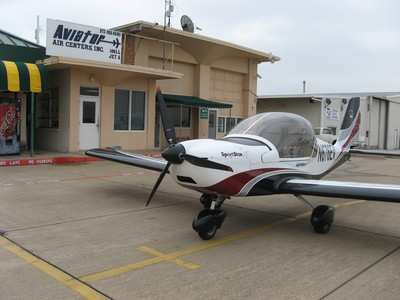
Instead, I'm content with puttering through the air, always
reasonably close to an airport, just sitting back and enjoying the
simple fact that "hey, I'm flying." IFR training doesn't hold very
much appeal to me, at least for now, and nighttime is for
sleep.
That puts me in a distinct minority among the pilot
community, and that's fine by me. Although for the moment I'm
relegated to sport pilot by default -- more on that later -- truth
be told, I've always been a sport pilot, even when I didn't know
it. And it appears I'm not the only one.
N676EV is but the first of two SportStars my flight school is
set to receive. Another one should be flying within a couple months
-- good thing, too, as 6EV is already booked at least one week in
advance. The school is one of only a few -- you can
count them on one hand -- in the entire DFW metroplex
currently offering sport-pilot training. Jay tells me all
but one of his current students are working towards their sport
licenses. It's clear the market is there... it's just waiting
for more schools to offer the option.
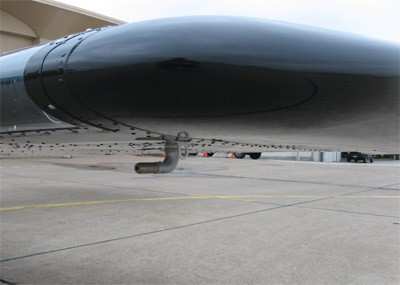
The Flight
Preflighting the Evektor is just a tad different than
preflighting a Skyhawk, but the basics are there. If you follow the
checklist, you'll be fine. I was taken aback a bit by the
all-in-one pitot/static tube on the underside of the SportStar's
left wingtip (above), as well as the need to check the engine
coolant level (below) on the Rotax powerplant.
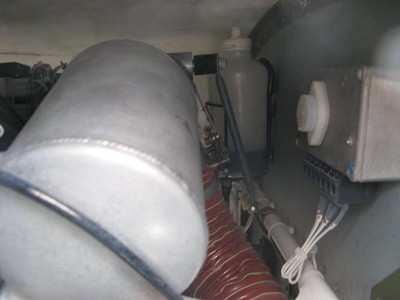
As I'd discovered at Sebring
2007, climbing into the SportStar is fairly
simple... a big consideration, as I'm not as thin as I used to
be. Once inside, I was again impressed with the amount of room
available. That big canopy also gives you plenty of shoulder
room... and the view out is incredible.
After a thorough review of the SportStar's cockpit and controls,
it was time to get underway. Jay instructed me to flip the fuel
tank selector to the left position, and crank the Rotax the same as
I would start my car -- be ready for a quick start, and keep the
throttle at idle. The lightweight powerplant turned over
instantly.
Taxiing the SportStar was a nonevent. I was awed by the
fantastic view over the nose; the proximity to the ground helped me
line up on the centerline much easier than in the Cessna 172s I
have flown before.
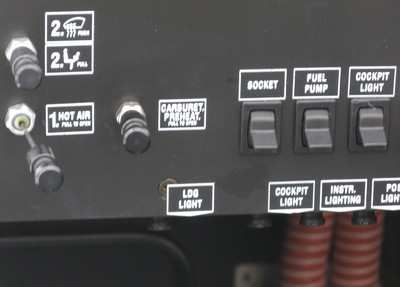
The preflight run-up is pretty much the same as the Skyhawk...
except for the different control locations. The split-flaps are
controlled by a Johnson bar between the seats, not via a
panel-mounted electrical switch (on this plane, anyway; electric
flaps are an option). Carb heat is a (very) small, somewhat-flimsy
lever on the left side of the panel, not the center
as in several other planes. And speaking of that... the mixture
knob? Not needed on the Rotax. A very welcome absence, if you
ask me.
Also on the subject of "missing" equipment... where's the
directional gyro? In keeping with 6EV's strictly-VFR mission in
life, heading information is provided solely by a magnetic compass
at the top of the panel. The only gee-whiz aspect in this
SportStar's cockpit is a Garmin 396, secured in a panel-mounted
bracket at top-center.
With the runup complete, we taxied to the end of runway 35 and
scanned for traffic in the pattern. Grand Prairie Muni is also home
to American Eurocopter; one whirlybird was on downwind.
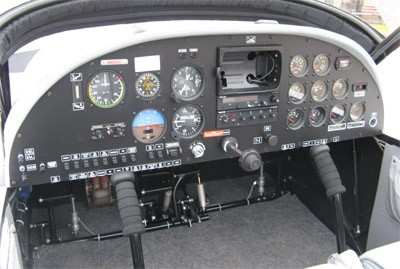
"What is our rotation speed?" I asked Jay after we received
clearance from the tower.
"For this takeoff, don't think about that," he replied. "Feel
the plane tell you through the stick when it's ready to
takeoff."
For the record, that speed comes at 52 KIAS... but the plane
felt ready and eager to fly well before that. With only the
slightest backpressure, 6EV lifted off the runway, with the
nose oriented with the horizon in the proper climb
attitude. At 500' AGL, we banked right, and departed to the south
on the downwind. Despite the SportStar's considerably lighter
weight, the ride was just slightly bumpier than I remember in the
Skyhawk.
The practice area south of GPM is a busy place. In addition to
the big jets flying overhead on approach to DFW, one must also keep
an eye out for traffic from Arlington Airport, just seven miles
southwest of Grand Prairie.We also had a Chinook helicopter from a
nearby base cross underneath. I wish I'd brought my camera.
But that would have taken away from the purpose of this flight.
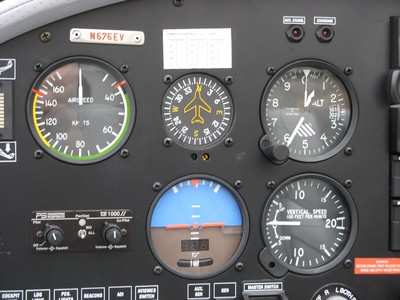
"Climb to 2,500 feet ... okay, make a left turn to 090 down to
1,500 feet," Jay instructed me. "Take us back to 2,000 feet, and
right to 270."
Compared to a Skyhawk, the SportStar is a highly
responsive aircraft. It feels much faster than its actual speed
belies, a sense heightened by the panoramic canopy. More
importantly, it is also an easy plane to fly reasonably well; from
the start of our maneuvers, the SportStar responded to my control
inputs like a faithful steed, going exactly where I pointed it.
Maybe there wasn't as much rust on my negligible skills as I'd
thought... or maybe, the SportStar tries its darnedest to make its
pilot look good. The only aspect I found slightly difficult -- more
of a nuisance, again given this plane's VFR-only mandate -- is the
lag from the plane's magnetic compass. Turning out to an exact
heading is less a science, more of an approximation.
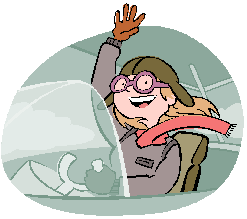 Next up, Jay
demonstrated power-off and power-on stalls, and then had me fly a
series. I've never liked stalls; in fact, I flat-out hate them.
Always have. The SportStar didn't change my mind on this... but
surprisingly, stalls in the SportStar didn't unnerve me like they
used to in the Skyhawk. In fact, they were almost... well, not fun,
but rather enjoyably challenging. I again surprised myself by
looking -- and feeling -- like I knew what I was doing.
Next up, Jay
demonstrated power-off and power-on stalls, and then had me fly a
series. I've never liked stalls; in fact, I flat-out hate them.
Always have. The SportStar didn't change my mind on this... but
surprisingly, stalls in the SportStar didn't unnerve me like they
used to in the Skyhawk. In fact, they were almost... well, not fun,
but rather enjoyably challenging. I again surprised myself by
looking -- and feeling -- like I knew what I was doing.
With stalls completed, we headed back to the airport. I'd lost
track of the time (except for the half-hour mark ,when we changed
fuel tanks... another difference from the high-wing Skyhawk.) The
95-knot trip back to the airport gave me ample time to go over the
flight in my mind.
Being in the air again felt like home. I couldn't believe it had
been so long since I'd last been at the controls of an aircraft for
an extended period of time... I had to pause to remember my last
solo flight was June 2005.
All in all, it was a much better day than it had been
exactly one year ago: January 24, 2006. A Tuesday... the first of
many I'd never look at the same way again.
****
"It looks like cancer," the radiologist had told me that
day, one year ago. "We're recommending surgery
immediately."
They say time slows in moments like that... and it does. But
my mind raced. I was only 30, and had recently started a "dream
job" at Aero-News; in fact, my life had become something of a
storybook in the past three months, and I was more content than I
could remember being in quite some time.
One reason for that was I also looking forward to resuming
flight lessons; in fact, as I awaited the results of the test, I
had calmed myself by mentally flying the pattern at my local
airport.
Cancer. It wasn't fair... but then again, what is?
The surgery was one week later, also on a Tuesday. My mom
drove down to stay with me. The days that followed would bring more
good news than bad. The tumor didn't look like it had
spread... and the doctor felt there was no reason to go through
chemo. Monthly observation checkups would tell us if we needed to
alter that game plan.
I was -- I am -- lucky. The form of cancer I was struck
with, although voracious in its appetite, is also relatively easy
to kill. It depletes its energy in spreading... not with sticking
around. Others have shown -- quite successfully -- it was possible
to beat it back, and live not just normal lives... but highly
successful ones, as well.
For the moment, however... no flying. And I
cursed my luck for that one reason, above all
others. Fortunately, it wouldn't last.
****
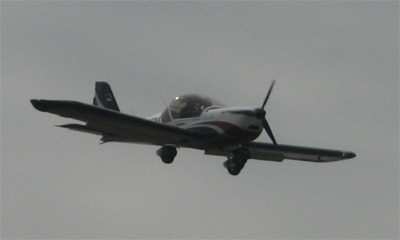
As Jay and I flew over the marina on the north edge of Joe Pool
Lake -- conveniently inline with the end of the runway at GPM -- we
called the tower, and received clearance to fly a straight-in
approach to 35. The wind was straight down the runway.
Two notches of flaps (30 degrees) set us up for a nominal
descent. We crossed the threshold at 60 KIAS, and I set the plane
down in a smooth, albeit three-point landing.
"You'll have to get used to flaring higher than you would in the
Skyhawk," Jay told me, "but apart from that, nice job!" I'd been at
the controls the entire time, except when Jay demonstrated the
stalls.
During the post-flight briefing, Jay set out a game-plan for
earning my sport-pilot ticket. I already have the hours required
for a sport pilot license -- several times over, in fact, the
result of that stop-and-start training -- so the next few lessons
would continue to be "check-out" flights ahead of soloing. "You
shouldn't take very long," he told me, and I agreed. Everything on
the first flight had felt natural to me.
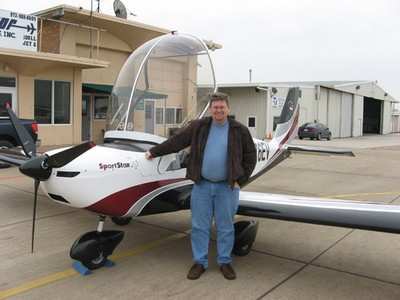
We set up the next lesson for the following Tuesday, I paid my
bill for the one hour flight($30 less than a comparable lesson in a
C172, I noted... hey, every little bit helps) and that was
that.
As I walked back to my car, I could feel my emotions
starting to get the better of me. I had to make one phone call
before heading for home.
"Mom, your son is flying again," I said.
Next Week... Steep Turns, And Strong
Winds!
E-I-C Note: The Aviation World lives off of
one inspirational miracle after another... but of all the little
miracles that I've ever been a part of, this "ANN Thing" has
been my favorite. This project has touched and involved more
people in more ways than I can possibly count and every new way
that ANN manifests itself as something cool or special in a
flyer's life is truly the delight of my life. And some more than
others...
Rob's odyssey since coming onboard at ANN is
something we take great pleasure in. He has a "no prisoners"
attitude toward every task that is put before him, and when his
"Big C" scare came about, I really wasn't that worried for his
mortality... as he is not the kind of guy to be stopped by simple
matters of mere biology... not when there's flying to be done. I
had every confidence that he would beat that challenge and look
forward to seeing him earn his SP ticket in the not too distant
future and joining the ranks of aviators throughout the world...
although, make no mistake about it, the guy has been an aviator,
with ticket or not, since the day I met him... --
Jim Campbell, E-I-C
 Aero-News: Quote of the Day (11.26.25)
Aero-News: Quote of the Day (11.26.25) ANN's Daily Aero-Term (11.26.25): Takeoff Hold Lights (THL)
ANN's Daily Aero-Term (11.26.25): Takeoff Hold Lights (THL) ANN's Daily Aero-Linx (11.26.25)
ANN's Daily Aero-Linx (11.26.25) Airborne Affordable Flyers 11.20.25: Sonex $$$, SnF 26 MOSAIC DAY, P. Ponk STCs
Airborne Affordable Flyers 11.20.25: Sonex $$$, SnF 26 MOSAIC DAY, P. Ponk STCs ANN's Daily Aero-Linx (11.27.25)
ANN's Daily Aero-Linx (11.27.25)













